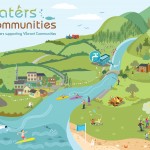The Environmental Protection Agency (EPA) has partnered with The Wheel…
Time to get real about addressing climate change impacts
After years of denial, procrastination and inaction, the time has arrived to get real about the impacts of a changing climate on Ireland’s environment, society and economy.
The effects of extreme events, such as storms and flooding and slow onset changes such as temperature rise, changes in precipitation regimes and sea level rise, will have a transformative effect on people’s lives, wellbeing, communities and businesses. It is now timely to plan to protect ourselves from the changes that are already upon us and those that are projected to arrive. This makes more social and economic sense in the long run rather than taking the more costly approach of cleaning up after events year in and year out.
This means, taking stock of what is happening to our climate, understanding how it is impacting on our natural and managed systems and preparing in an informed way for future climate risk at the appropriate administrative level.
Our local authorities have a key role to play in the development of strategies and plans to protect our communities, businesses and citizens from the effects of a changing climate. They in turn must be supported by central government, research, data and information providers to deliver evidence based decision making.

Ireland’s changing climate
Changes in Ireland’s climate are in-line with global trends. Observations outlined in The Status of Ireland’s Climate, 2012, confirm that:
- Temperatures have increased by about 0.8°C over the period 1900-2012; an average of about 0.07°C per decade;
- Average annual national rainfall has increased by approximately 60 mm or 5% in the period 1981 to 2010, compared to the 30-year period 1961 to 1990.
- Mean annual sea surface temperature, as measured at Malin Head, Co. Donegal, is now more than 1.0°C higher than the long-term average calculated for the period 1961–1990.
- Analysis of long-term river flows from over 40 measurement sites around the country shows a tendency for increasing annual mean flows.
A recent EPA report (Nolan, 2015) employed the method of Regional Climate Modelling to assess the impacts of a warming climate on the mid-21st-century climate of Ireland. The report states that:
- Mean annual temperatures will increase by 1–1.6°C;
- Heavy rainfall events will increase in winter and autumn;
- Storms affecting Ireland will decrease in frequency, but increase in intensity, with increased risk of damage.
Such climate change will have diverse and wide ranging impacts on Ireland’s managed and natural ecosystems, water resources, agriculture and food security, human health, and coastal infrastructures and zones. In fact, all sections of our society and economy will be impacted by a changing climate to varying degrees, depending on sensitivities and vulnerabilities. This could include direct impacts on, for example, water resources and quality or indirectly through impacts on business supply chains, human migration patterns and global food security.
How to act to protect ourselves?
The consequences of a changed climate will be felt most acutely by local environments, businesses and communities. The first line of defence in planning for this new environmental regime lies with the local authority sector. As the sector working closest to the ground, the local authority is best positioned to plan in a strategic way for changes within their communities. In the wake of extreme events authorities and agencies have to date largely been able to simply clean up, rebuild and return the affected area to some semblance of normality. But this will become increasingly difficult in future. The risk is that the costs of simply reacting to the impacts of climate change will spiral as extreme events become more severe, and the period of time between events will also shorten, diminishing the economic, physical and psychological capacity of affected communities to recover between shocks.
Reducing the impacts of climate change through mitigation action is the most immediate policy response. However, many impacts of climate change are ‘locked-in’ for decades to come (Intergovernmental Panel on Climate Change (IPCC), 2013). Due to the slow response time (inertia) of the climate system these changes are projected to continue and increase over the coming decades. Even if GHG emissions were stopped right now, some changes, such as sea-level rise, are projected to continue up to and beyond the end of this century. This means that we need to understand, manage and adapt to the risks posed by a changing climate.
Fortunately, there are a number of tried and tested approaches that will guide us on how to plan in a considered and coherent way for climate change. This will allow us to adapt our towns and cities, and the support systems they rely on, to the future impacts that climate change will bring.
The Local Authority Adaptation Strategy Development Guidelines and Climate Ireland
In May 2016, EPA research published Guidelines to make it easier for local authorities to plan for the inevitable consequences of climate change. The Local Authority Adaptation Strategy Development Guidelines (Gray, 2016) aim to support local authorities in the development of a local climate change adaptation strategy. This in turn, will support the implementation of the National Adaptation Framework, and associated international commitments.
The Guidelines were prepared by scientists at University College Cork’s Environmental Research Institute. The guidance, which is based on international best practice, the EU Adaptation Guidelines and extensive stakeholder engagement, can be used by a local authority to assess the adaptation fitness and coherence of its spatial plans and the other plans and policies under its remit. The guidelines follow a stepwise process to adaptation planning and subscribe to an adaptive risk management approach. They can be used in conjunction with the EPA funded climate information portal Climate Ireland – http:// www.climateireland.ie/climateinfo/about.html
These guidelines represent a first but important step for local authorities in planning for climate change. They will be supported by ongoing research, training and capacity building. They can be downloaded online: http://bit.ly/laclimate
Margaret Desmond, Senior Research Fellow, UCC/EPA
References
Dwyer, N. 2012. The Status of Ireland’s Climate, 2012. EPA Report No. 26. EPA: Wexford
Gray, 2016. Local Authority Adaptation Strategy Development Guidelines. EPA Report No. 164. EPA: Wexford.
IPCC, 2013: Summary for Policymakers. In: Climate Change 2013: The Physical Science Basis. Contribution of Working Group I to the Fifth Assessment Report of the Intergovernmental Panel on Climate Change [Stocker,T.F., D. Qin, G.-K. Plattner, M. Tignor, S.K. Allen, J. Boschung, A. Nauels, Y. Xia, V. Bex and P.M. Midgley (eds.)]. Cambridge University Press, Cambridge, United Kingdom and New York, NY, USA.
Nolan, P. 2016. Ensemble of regional climate model projections for Ireland. EPA Research Report No. 159. EPA: Wexford.







